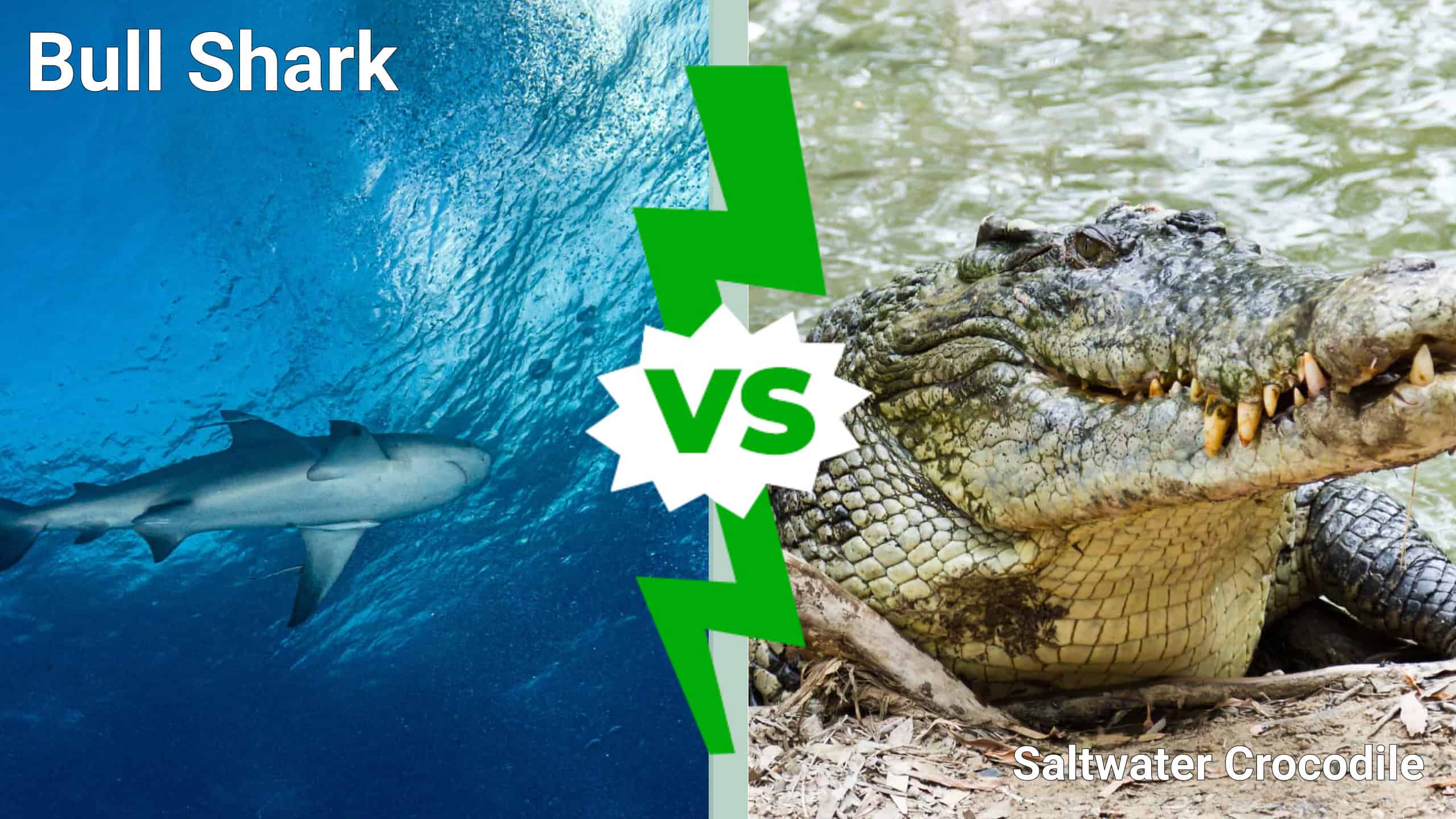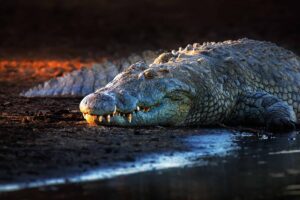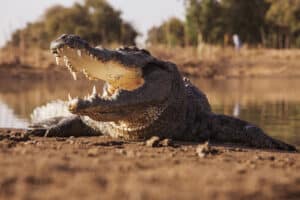Key Points
- A saltwater crocodile has a bite force of 3,700 PSI.
- Bull sharks have many adaptations, such as enhanced sense of smell and electromagnetic sensing capabilities, which make them thrive in the water.
- Saltwater crocodiles and bull sharks are seen as very aggressive apex predators, threatening humans and other animals.
Bull sharks and saltwater crocodiles are two of the deadliest animals on the planet. Both large, these two animals have been known to attack humans and display aggressive behaviors in their hunting habits. Although they are entirely different species, their paths cross far more often than people think. Both can survive in fresh and saltwater environments. Who would win a fight when these two apex predators go head to head? In this article, we will create a battle between the bull shark and saltwater crocodile and compare their key features to determine which animal would come out on top.
Comparing a Bull Shark and a Saltwater Crocodile
Below is a table summarizing the main key factors of a bull shark vs. a saltwater crocodile.
| Category | Bull Shark | Saltwater Crocodile |
|---|---|---|
| Size | 200-550 pounds 11 feet long | 500 plus pounds 10-20 feet long |
| Speed and Movement Type | Swims well Strong fins and tail 25 mph in water | Strong tail and webbed feet 15-18 mph in the water 22 mph on land |
| Defenses | Very thick skin Quick maneuverability in the water | Scaled, armor-like skin Camouflage coloring Ability to move on land and in water |
| Offensive Capabilities | Tons of needle-like teeth 1,300 PSI bite force | Strong conical teeth 3,700 PSI bite force |
| Predatory Behavior | Aggressive, opportunistic hunters Enhanced smell, sight, and electromagnetic senses | Aggressive, opportunistic hunters Enhanced smell, sight, and electromagnetic senses |
What Are the Key Differences Between a Bull Shark and a Saltwater Crocodile?
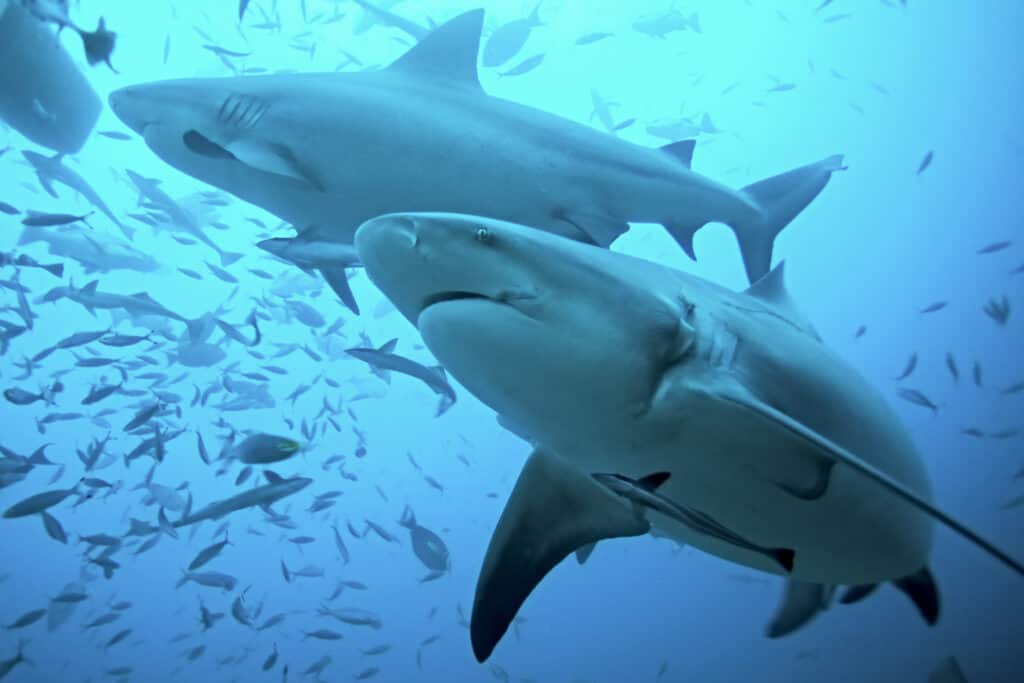
©Martin Prochazkacz/Shutterstock.com
The key difference between a bull shark (Carcharhinus leucas) and a saltwater crocodile (Crocodylus porosus) is their class. Bull sharks are considered fish; they have gills and live their entire lives in the ocean. Saltwater crocodiles are reptiles; they have lungs and need to breathe air. Their need to breathe air means that they do not solely exist in the water as sharks do. The saltwater crocodile lives both in the water and on land.
Despite their seemingly different habitats, these two apex predators meet in the wild more often than people think. Bull sharks are found in warm, coastal waters of the ocean. They are usually found in water less than 100 feet deep. However, bull sharks are unique because they can also exist in freshwater! These sharks can swim in freshwater because of a process called osmoregulation. This process allows the shark to adjust the water and salt levels within its body. Bull sharks occasionally use rivers and other fresh bodies of water to migrate, where they could easily encounter a croc.
In addition, the saltwater crocodile can exist in fresh, brackish, and saltwater. They can do this because of their lingual salt glands, which help them balance their electrolytes. These two apex predators can easily meet in estuaries, mangrove swamps, and river mouths. Saltwater crocodiles even swim out around the brackish water around coastal regions of the ocean, so these two likely encounter one another; the question is, what would happen if they do?
What Are the Key Factors in a Fight Between a Bull Shark and a Saltwater Crocodile?
Seeing as these are two of the world’s top apex predators, it can be hard to imagine which animal would win in a fight. To determine this, we must discuss the key factors of these animals. The following section will present data on each animal’s size, speed, movement type, offensive and defensive capabilities, hunting, and predatory behavior.
After presenting the data, we’ll know whether the bull shark or the saltwater crocodile would win this fight.
By the time we’ve finished presenting all of the data, we’ll know whether the bull shark or the saltwater crocodile would win this fight.
Bull Shark vs. Saltwater Crocodile: Size

At over 2,000 pounds, the average saltwater crocodile is much larger than the average bull shark.
©Firepac/Shutterstock.com
Both the bull shark and the saltwater crocodile are massive animals. The average male bull shark weighs between 200-500 pounds and is about 11 feet long. However, the female bull sharks are even more giant! The typical female bull shark will weigh double that of the male! The largest bull shark ever recorded weighed around 1,000 pounds.
Saltwater crocodiles are the largest crocodiles in the world. They are also the largest reptile in the world. These crocodiles easily weigh 500 pounds and have even reached 2,200 pounds! They average between 10-20 feet in length. The largest saltwater crocodile recorded was 20 feet, three inches long, and nearly 2,400 pounds.
The saltwater crocodile is much larger than the bull shark, so it wins the advantage in this category.
Bull Shark vs. Saltwater Crocodile: Speed and Movement
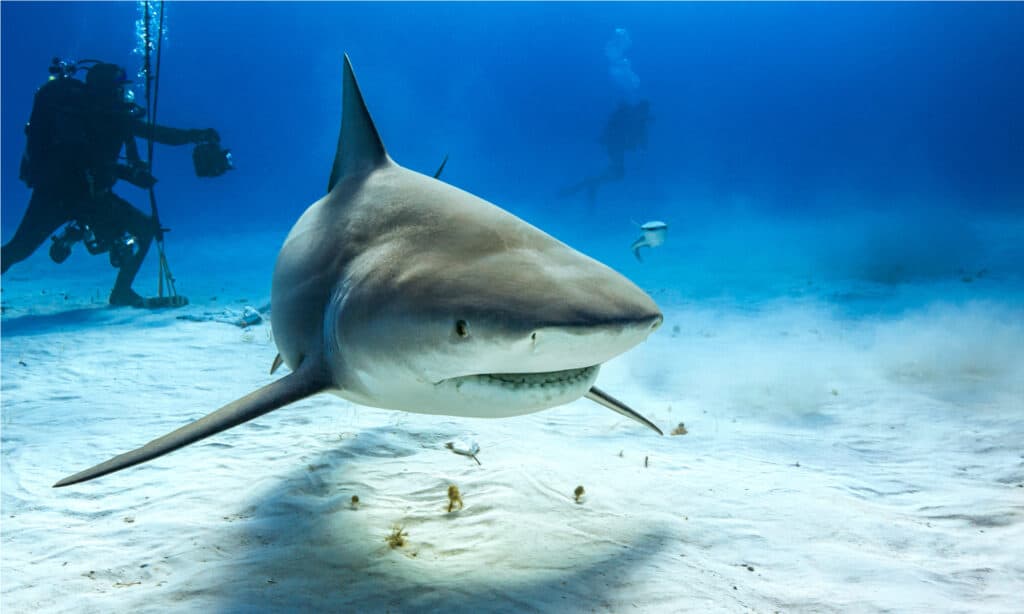
Female bull sharks are usually double the size of males, easily weighing between 400-600 pounds.
©Carlos Grillo/Shutterstock.com
Bull sharks are well equipped for movement in the water. They have strong fins that quickly cut through water and a large tail that propels them through the ocean. Bull sharks can sustain speeds of up to 25 mph. They are also powerful swimmers! They are often found upstream; one was even found almost 2,500 miles from the ocean!
Crocodiles also have muscular tails that propel them through the water and webbed feet that help them move upward and downward. Even with those adaptations, however, crocodiles can only reach speeds of 15-18 mph in the water and only do so in short bursts. However, one area that these animals can move that the sharks cannot is on land. While these crocodiles can hit speeds of up to 22 mph on the ground, their saltwater crocodile size usually makes it a bit slower. Similarly to their water speed, the saltwater crocodile can also average 15-18 mph on the land.
This fight would have to occur in the water so both animals could be present. The bull shark can swim much faster, so they have the advantage in this section.
Bull Shark vs. Saltwater Crocodile: Defenses
Each of these apex predators comes with its own line of defense. Bull sharks are cartilaginous, meaning that they have no bones. Instead, their cartilaginous skeletons are much lighter, which is one of the things that allows them to stay buoyant in the water. While this may open them to attack, these sharks have thick skin. The bull shark’s skin is tough, about six inches thick, and can take a surprising amount of damage. This skin is useful during mating season when the male sharks bite and latch onto the females to hold them in place and when encountering predators. Their skin and ability to quickly maneuver in the water provide them with two outstanding defenses.
Saltwater crocodiles also have defensive skin. Their thick, scaled skin provides them with a layer of armor, which makes them hard to bite and attack. Another thing that makes them difficult to attack is their size. Being the largest reptile in the world comes with its advantages; many animals do not want to challenge an animal of the saltwater crocodile’s size. In addition, their ability to move on the land and in the water aids their defensive tactics. They can escape land predators by entering the water and water predators by running onto the ground. Their unique coloring — dark green on the sides and back, tan on the belly — also allows them to blend in in both environments, with the murky water, mud, and nearby vegetation.
Although the saltwater crocodile has better “armor,” the bull shark has the advantage of more effortless mobility — and escape capabilities — in the water, so in this section, we will call a tie.
Bull Shark vs. Saltwater Crocodile: Offensive Capabilities
Bull Shark
The most incredible offensive capability of the bull shark is its mouth. Inside of that mouth, there are 350 plus teeth at a time! That’s right, these sharks have 50 rows of teeth, each with seven teeth. Although their teeth are about one inch long, they have massive roots and are covered in tiny serrations. These small serrations come in handy when gripping their prey. In addition, the bull shark’s teeth are narrow, needle-like, and triangular, perfect for biting into game and tearing flesh easily. They are also great at holding onto slippery prey and piercing shells.
The bull shark’s teeth allow it to quickly grab its prey before swallowing it. That’s right, they use their teeth to grip their prey only. Bull sharks do not use their teeth to grind or chew their food; they swallow their prey whole. Their teeth continue to shed and grow back throughout their life. In one lifetime, they can lose and grow up to 20,000 teeth. In addition to their deadly teeth, another dangerous offensive capability of this shark’s mouth is its bite force. Stronger than the tiger shark and the great hammerhead, the bull shark has a bit force of 1,300 PSI! The bull shark is not an animal you want to get bit by!
Saltwater Crocodile
Saltwater crocodiles also have most of their offensive capabilities in their mouths. They have long snouts full of conical teeth. They use these teeth to clamp down on their prey and are known for tearing large chunks of flesh from them. These animals have fewer teeth — only 66 — but that does not mean they are less intense. Those 66 teeth are each about five inches long and are specifically designed for ripping and tearing their prey. And those teeth live inside of a mighty jaw.
The saltwater crocodile has the strongest bite force of any reptile and terrestrial animal. They have a bite force of 3,700 PSI! Their bite force is one reason they can take on large prey such as pigs, water buffalo, and kangaroos.
Although the bull shark has more teeth, there is no competition with the strength of the saltwater crocodile’s bite force. The saltwater crocodile has the advantage of offensive capabilities.
Bull Shark vs. Saltwater Crocodile: Predatory Behavior
Bull Shark
As one of the most aggressive shark species bull sharks are the third most dangerous shark to people. These sharks are considered apex predators. With their large, muscular bodies, they easily maneuver through the water. These sharks are opportunistic hunters and have a varied diet. They eat fish, other sharks, stingrays, turtles, birds, and dolphins. Bull sharks tend to use their head to bump into prey before attacking them as part of their hunting technique.
Another way the bull shark hunts is with its sense of smell, which is 10,000 times more powerful than a human’s. A shark can detect a single drop of blood in water from a distance up to a quarter of a mile away. In addition to their sense of smell, sharks rely heavily on their acute sense of hearing when hunting for prey. Sharks don’t hear like you and me; instead, they have an organ that allows them to detect vibrations in the water and an inner ear to detect low-frequency sounds. They also have enhanced vision with a special membrane reflecting light back to their retinas, allowing them to see in low light and easily detect movement. Bull sharks can also detect changes in the electrical fields of the water caused by the movement of their prey.
Saltwater Crocodile
The saltwater crocodile has a different predatory approach. Unlike the bull shark — who is opportunistic and quick to attack — the saltwater crocodile is more stealthy. These crocodiles are not only apex predators but ambush hunters. They often lurk along the water’s edge and use a violent lunge attack when their prey gets near the water. These crocodiles like murky water, where they can hide and wait. They can lie stealthy without moving for up to seven hours! This croc can also stay submerged under the water for an hour; that is a lot of time to wait for their prey to pass by stealthily. They also possess special eye membranes that cover their eyes, allowing them to have clear vision underwater.
The saltwater crocodile has a variety of prey, feasting on fish, birds, feral pigs, wallabies, and reptiles. They are even known to attack humans. Crocodiles have one of the strongest bite forces in the world, and they use it to their advantage when attacking their prey. Saltwater crocodiles often drag their prey into the water, where they have more of an advantage over any land prey. They are also famous for doing a death roll, where they grab their prey in their powerful jaws and roll them over multiple times. The death roll is used to stun, dismember, and snap the neck of the crocodile’s prey. Crocodiles are known to drown or seriously injure their prey before consuming it.
The bull shark has many great adaptations that allow it to detect prey in the water, but the saltwater croc can avoid movement that would alert the shark, and it can easily lay in wait for the shark to swim by; this category is a tie.
Who Would Win in a Fight Between a Bull Shark and a Saltwater Crocodile?
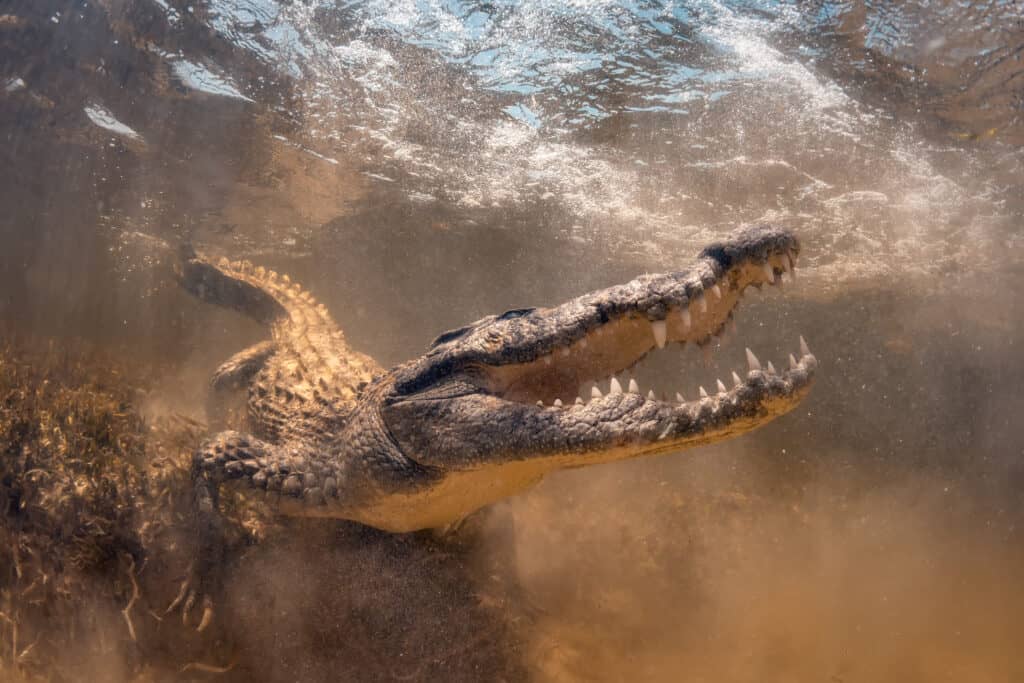
The saltwater crocodile is the largest crocodile in the world and has one of the strongest bite forces of any animal.
©Alexander Machulskiy/Shutterstock.com
In a fight between a bull shark and a saltwater crocodile, the saltwater crocodile would win. While the shark is adept at hunting in the water and most definitely an apex predator, the saltwater crocodile has its skills.
With its ability to lie still and hide from the bull shark’s movement-detecting skills, it has the advantage of stealth. Also, its large size and protective scales provide a great line of defense against the shark’s needle-like teeth.
Once gripped in their powerful jaw, with their massive bite force, the bull shark wouldn’t stand a chance. The saltwater crocodile would win this fight with a final death roll blow.
Another Animal That a Saltwater Crocodile Could Take Down: Saltwater Crocodile vs. Jaguar

Jaguars are very similar to leopards in appearance, but their bodies are heavier and more robust.
©Adalbert Dragon/Shutterstock.com
The saltwater crocodile would defeat the jaguar with ease as well. Although jaguars can use their strength and cunning skills to take down small crocodilians easily, they are no match for the saltwater crocodile. The saltwater crocodile dwarfs the jaguar in size. The average jaguar weighs between 120 and 300 pounds, whereas the crocodile can weigh up to 2,000.
The jaguar does possess strong, sharp claws and a powerful bite, but their bite force is only 1,500 PSI; this pales in comparison to the saltwater crocodile’s bite force of 3,700 PSI. While the jaguar may have excellent hunting capabilities, such as immense speed and enhanced night vision, they could not risk using those skills on the saltwater crocodile without getting dangerously close to it.
If the jaguar got too close to the crocodile, the crocodile would capture it in its powerful jaws, and it would lose immediately. To see a full breakdown of the fight, read “Jaguar vs. Crocodile: Who Would Win in a Fight.”
Thank you for reading! Have some feedback for us? Contact the AZ Animals editorial team.

